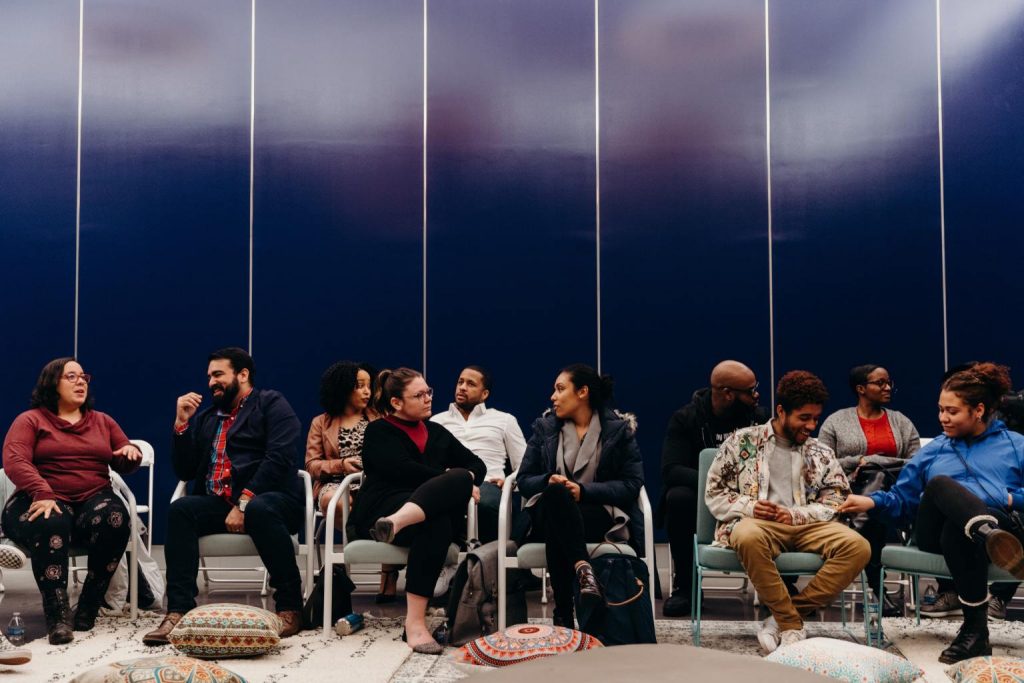Interactions
Neighbourhoods refers to large areas based on the City of Toronto’s formal division of areas (E.g., Dorset Park and Mount Olive).
Routes are smaller areas within neighbourhoods that we used for scheduling surveying sessions. Routes were developed based on number of houses to visit and the total area.
Letter and flyer are physically printed materials given to residents as a reminder to complete the survey.
Protocol are the procedures and processes for surveying the target population.
Residents refer to individuals who surveyors asked to complete the survey. In this handbook, we use residents unless otherwise specified.
Participants are individuals who agreed to complete the survey.
Replenish is a meeting between the survey coordinator and surveyors to exchange necessary materials and formulate solutions to any survey-related challenges.
Replenish Protocol is an outline developed for each replenish that outlines which surveyor is responsible for which route and what materials are needed from the survey coordinator.
How did we interact with residents of diverse backgrounds?
We interacted with a diversity of residents and were exposed to a range of responses. In this section, we discuss the challenges we faced and the strategies we used to interact with residents from diverse backgrounds.

A. Planning Considerations
- Is there a seating area available?
- Is there a public washroom?
- Is there food available for purchase?
- Are there any parks or restaurants in the area?
- Are there any safety concerns?
- How busy are the roads?
- Is the route most houses or mostly apartments or a mixture?
- In extreme cold or hot weather, surveyors rotated between houses and indoor complexes, and apartments.
- In inclement weather (e.g., heavy rain or flash floods), surveyors identified potential places to take shelter throughout the route.
- Ensure that surveyors carried sufficient supplies such as water and snacks.
- We identified any ‘hotspots’ prior to entering the neighbourhood by communicating with community advisors who can explain the best approach to survey in the area.
- Surveyors visited well-lit apartment buildings for the later evening if the route had a mix of houses and apartment buildings
- Surveyors identified the location where they will leave the route to go home at the end of the shift
- A minimum of 3 weeks ahead allowed apartment management to notify residents and ease any security concerns.
- Emailing, calling, visiting, or some combination of the three was necessary to build rapport with apartment management.
- If management refused or took too long to respond, community advisors stepped in, especially if they lived in a building on the survey route.
- Community advisors also accompanied surveyors with in-person visits when seeking permission from apartment management.
- Surveyors placed the flyers in the order the route will be completed.
- Surveyors incorporated any houses to follow up into the surveying plan for the shift.
- If surveyors believed that they could complete the route earlier than usual, then they contacted the survey coordinator who found alternates for them to continue surveying.
B. In the Neighbourhood
- This gave residents the opportunity to ask questions about why they are surveying in their neighbourhood.
- Surveyors may stand out or appear suspicious to residents in close-knit neighbourhoods, ethnic neighbourhoods, or wealthy neighbourhoods. By initiating interaction and responding to questions, surveyors eased concerns while also building rapport and credibility.
- This is especially important if residents are home, since standing on the property for prolonged periods of time may appear suspicious in some areas.
- Surveyor mannerisms reflect not only other surveyors who may visit the neighbourhood but also the organisations involved in delivering the survey. Surveyors are ambassadors of organisations.
C. Approaching the Residence
- Surveyors spotted any tripping hazards in the area.
- If surveyors noticed a hazard, they communicated this information to their partner.
- Surveyors avoided approaching households or starting survey routes for the first time close to sunset. An exception can be made for well-lit apartment buildings.
- Surveyors left the flyer in the residence mailbox
- Surveyors skipped the residence, continued the route, and returned at a later point during the day.
- Surveyors skipped the residence, continued the route, and returned another day. Surveyors noted on the Google Sheet that the residence was not visited.
- Surveyors mentioned the safety concerns to the coordinator.
Cues to look for include:
- Religious symbols
- National flags
- Decorations or signs in a particular language
- Surveyors apologised to the resident for bad timing.
- Surveyors offered them a flyer so they can complete the survey at their own leisure.
- If residents appeared willing, surveyors arranged another time and day to come back.
- If superintendent or security are present, surveyors promptly presented themselves, explained their reason of visit, and described the exact residences they intend to visit. Surveyors also let them know when they were expected to exit the area.
- In most cases, the expectation was that “solicitors” call ahead and receive permission from building management to post a flyer on the building bulletin board. However, we have found that after explaining the nature of the project in-person, some staff were willing to compromise. In some cases, apartment management allowed surveyors to visit all residences. In other cases, they offered to deliver flyers to the residences we specified.
D. First Point of Contact
First impressions are important because they set the tone of the interaction. Below are some ways for surveyors to present themselves in a positive and professional manner.
- Surveyors stood back far enough so that they are visible through the peephole or doorbell camera.
- Both surveyors were in the line of sight so that a resident is not surprised by the presence of additional people when they open the door.
- Conversation out of context can seem inappropriate or suspicious to approaching residents.
- Surveyors kept clipboards and writing observations out of the direct line of sight to maintain an approachable demeanour.
- Surveyors smiled in a friendly manner.
- Surveyors acknowledged the resident with a wave of their hands.
- Surveyors showed their organisation ID.
- Surveyors establish their identity as students of an educational institution.
- Surveyors ensured that their institution-affiliated apparel is visible (e.g. lanyard, name tag with logo, student card, stylised clothing, etc.)
- Community researchers led interactions when surveying communities where they reside.
- Community researchers leveraged their relationship with individuals in the community and build rapport between the outside institution and community members.
Make note of things like:
- The resident’s garden, vehicle, or residential decorations
- Surveyors also related to a resident that is wearing clothing in support of a particular sports team/brand
Sometimes despite surveyors’ best efforts at a positive first impression may be met with hostility for a variety of reasons.
- Residents may think you are a solicitor.
- Residents may be having a bad day.
- Residents may believe that a survey will have no meaningful contribution to them or their neighbourhood.
This is likely to happen at some point during your time in the field, so it is worthwhile to prepare for it practically and emotionally.
- If a resident goes on a rant, surveyors should:
- Briefly listen to their grievances.
- Acknowledge their concerns in your response.
- Show sincerity through tone and body language.
- Explain that they can document and share their ideas through the survey format.
- Explain that you have to continue on the route.
- Provide the contact information of the survey coordinator.
- If a resident yell, surveyors should:
- Acknowledge their concerns.
- Apologize for any inconvenience.
- Leave the resident’s property and be far enough that they can’t see or hear you.
- Do not leave a flyer or return to the residence another day.
- If there are other residences close by, skip them and come back at a later.
E. The Interaction
The AIDET acronym developed by Studer Group is used as a communication strategy. It is designed to facilitate the communication of information between healthcare professionals to patients in a way that reduces anxiety and increases patient satisfaction and compliance.
AIDET includes the following steps: acknowledge, introduce, duration, explanation, and thank you, although not necessarily always in that order.
We used the AIDET framework when interacting with residents. AIDET enabled our surveyors to cover all the necessary information points in a condensed and efficient manner. We adjusted the steps by placing “explanation” before “duration,” which proved to be more effective in the field.
| Acknowledge | Greet residents in a pleasant manner. “Hello, how are you today?” |
| Introduce | Introduce yourself and your colleague while briefly explaining your role/position and what organisation/institution you are representing. Show the resident your organisation ID. “My name is _______ and this is my colleague _______. We are (role/position) from (organisation/institution).” |
| Explanation | Briefly explain your business in their neighbourhood and why they are visiting the residence. Touch on some points of the survey that the resident may be able to relate to or have an opinion on. “We are conducting a survey in your neighbourhood and are looking for residents’ opinions on (points).” If the survey involves compensation, you might consider mentioning that as well. Compensation may also be mentioned after the resident is informed of the survey duration. If there is compensation: “For your time you will receive _________ as compensation,” or “To show our appreciation we are offering _______ as compensation for participating.” Some residents may be offended by the idea of receiving compensation as they have a genuine interest in the betterment of their community. Acknowledge their concern. “I understand where you are coming from and appreciate your dedication to the community, but your time is valuable.” If a resident asks why their neighbourhood was chosen, be mindful of the language used when explaining why the neighbourhood was chosen for the study. Avoid terms like “poor” or other terms which can be offensive. |
| Duration | Inform the resident on the average time it takes to complete the survey. “It takes about (time) to complete.” The resident will then decide on whether they wish to participate. |
| Thank You | Thank the resident for their time regardless of whether or not they agreed to complete the survey. Encourage them to reach out to your organisation if they have any further questions, concerns, or difficulties. Surveyors should have this contact information easily accessible. Agreed: “Thank you for completing the survey. We really appreciate you taking the time and being willing to offer your opinions. Do you have any further questions before we go?” Come back another time: “Thank you for taking the time to speak with us, we will follow up with you (agreed upon time/day). Declined: “Thank you for taking the time to speak with us, have a good day.” |
F. Resident’s Response: Agrees to Complete Survey
Some residents may invite surveyors inside their house or offer you food and beverage while they are completing the survey as an expression of hospitality.
- Surveyors should thank the residents for their generosity and politely decline the offer.
Surveyors should always consider accessibility regardless of whether the survey is completed using pen and paper or technology.
- Surveyors should ask the resident if they are comfortable with using the format they have.
- Some elderly persons, persons with disabilities, or English language learners may prefer for surveyors to read out the questions and fill in the response options for them.
Surveyors should always explain consent and privacy to anyone who agrees to do the survey.
- Explain that the participant’s consent is ongoing and that all their responses will be anonymous.
- This should be done especially if the residents did not the consent form fully.
Surveyors should verify the age and residence of anyone who agrees to do the survey.
- For anyone that appears under the age of 25, surveyors should immediately ask if they are 18 years of age or older.
- If the answer is “no”, surveyors should thank them for their time and explain they need to be of legal age to partake in the survey.
- Surveyors should also verify that anyone who agrees to complete the survey is a resident of the area being studied in the survey. Sometimes visitors from other neighbourhoods or cities open the door.
Surveyors should be mindful of how close they are standing to participants while completing the survey.
- Surveyors should not stand too close to participants during survey completion for privacy and response bias reasons. Some participants may feel comfortable talking to surveyors while completing the survey.
- Standing too far from participants can also be problematic. Residents may feel disinterest on the part of the surveyors.
- It is also important for surveyors to be aware of their surrounding environment and continuously evaluate the situation for any safety risks during the survey process.
Participants may be very vocal about their opinions on certain subjects. Surveyors should remain impartial to avoid any bias.
- Acknowledge that the participant is speaking with “interesting” or “I understand”, but do not state agreement or disagreement.
You should inform participants that you are available for clarification regarding wording or questions.
- Surveyors may find using synonyms helpful when trying to clarify the wording of a question to a participant.
- When clarifying wording, it is important that surveyors refrain from using potentially biasing language (personal examples and opinions) or non-verbal cues (tone of disdain, grimace, eye rolling).
- Click here to see a number of example questions from our survey that required clarification and how we clarified them.
| Example Question that Requires Clarification | Potential Solution |
| “In what neighbourhood do you currently live in?” | Restate the question in a different context: “If you’re at a party and someone asks you: ‘in what neighbourhood do you live in?’, how would you respond? That would be sufficient for answering this question.” |
| “Type of housing” | Bring the participant’s attention to response options under the question to give them examples. This may help clarify without having to explain further. |
| “City Hall” | List synonyms that the participant may recognise or understand better: “City of Toronto, local government, municipal government” |
| “Local charities and agencies” | List local organisations in the community that the individual may recognise: “YMCA, Toronto Community Housing” |
| “Unions” | Define the term: “An organisation that represents workers’ rights” |
G. Concluding the Survey
- Remind them to double-check that the email they have entered into the survey is correct.
- Advise them on the approximate time it will take for them to receive their compensation. Advise them to check their spam folder.
- Offer to leave the contact information of the survey coordinator so that they can follow up if they have any concerns about their compensation.
- Donates it to their favourite charity.
- Buys a pizza for their family.
- Give the compensation to another member of the household or someone they feel could benefit from it.
- Inform them that it makes things difficult for the survey team if they do not accept the compensation.
- Suggest alternative methods (e.g., gift card, cash).
- If participants still refuse to accept compensation, notify the project coordinator.
- Provide a general timeline for when the research is expected to be completed.
- Make note that they would like to be sent a copy of the results and pass on their contact information to a survey coordinator. Ideally, this should be an option in the survey itself.
-
- Brainstorm the various considerations surveyors need to make during planning to enter neighbourhood, when in the neighbourhood, approaching a residence, first point of contact with a resident, the interaction with the resident, and the resident’s response to completing the survey.
- Use AIDET (acknowledge, introduce, duration, explanation, and thank you) as a framework for interacting with residents.
- Consider questions on the survey that might cause confusion and develop strategies on how to address the confusion in the field.
- Review the survey to develop a list of FAQs that surveyors might encounter from residents before and during the survey.
- Leverage the initial training session to develop an understanding of the various situations that surveyors might encounter in the field, as well as the considerations they need to make.
- Acknowledge that the training may not equip surveyors with everything they need; they will encounter new situations. Curate new experiences and use them as learning opportunities for the surveying team.




